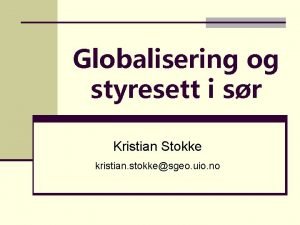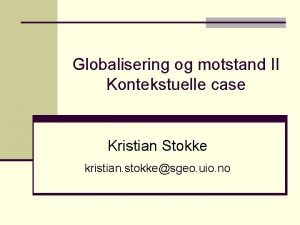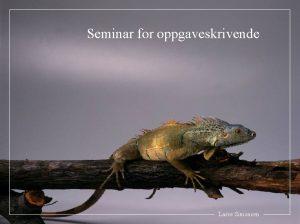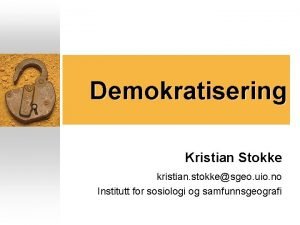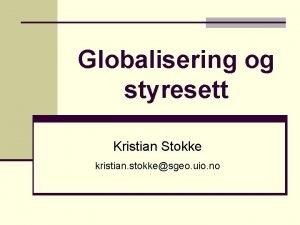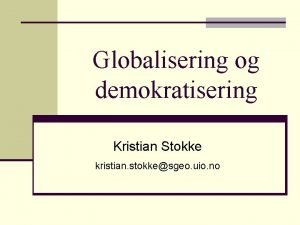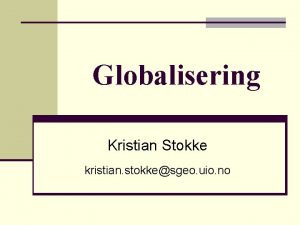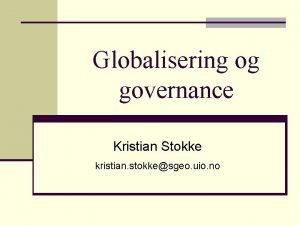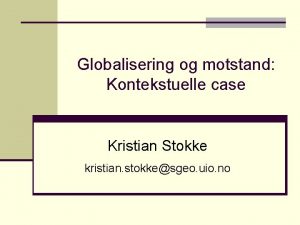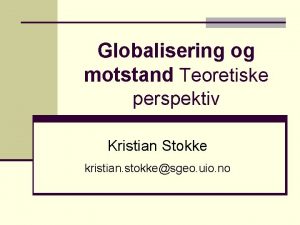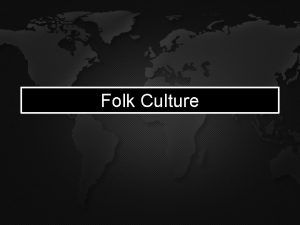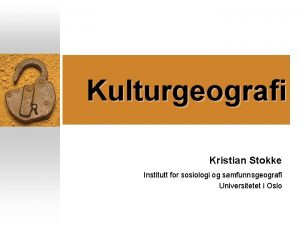Struktureringsteori Kristian Stokke kristian stokkesgeo uio no folk
















- Slides: 16

Struktureringsteori Kristian Stokke kristian. stokke@sgeo. uio. no folk. uio. no/stokke

Utgangspunkt n Reaction against structural Marxism (and to a certain extent interpretive approaches) n ”Structural Marxism was criticized as overly abstract, a totalizing and deterministic conception of human existence which left little room for the autonomy of consciousness or the actions of individuals” Peet p. 153) n Question: what does this mean? Examples from human geography?

Reflexive action n Stratification model of the human agent n Embedded in actor: motivation of action, rationalisation and reflexive monitoring n Continuous monitoring of activities and the social and spatial contexts of their actions n Recursiveness: action might not be completely understood or intended but is structured and often routinised

Duality of structures

Time-space relations n Presences/ absences n Time/space routinization/ time -space distanciation n Modes of regionalisation channeling social life into and out of locales

Structuration geography? n Sensitizing geographers rather than providing a framework for geographic research n Agency n From ”people as bearers of social relations” to ”people making their own history, although under conditions not of their choosing” n Locale n From ”place as a given local scene” to ”the becoming/making of place”

Constructivist structuralism/ structuralist constructivism n Compared to Giddens: n From rule to strategy (governed by habitus) n From resources to forms of capital n From institutions to fields n What people do – their social practices – are constituted by and constitute their dispositions (habitus), the capital they possess and the fields within which they operate.

(Habitus * Capital) + Field = Practice

Habitus n Habitus is a structuring mechanism for social practices that operates from within actors. n The habitus is a system of internalized social norms, understandings and patterns of behavior, in other terms, embodied dispositions (or ‘practical sense’) that incline actors to act in certain ways. n The dispositions of the habitus are acquired, structured, durable and transposable.

Habitus n Dispositions are acquired, particularly through childhood socialization, and constituted through unreflexive and mundane processes of habit-formation. n Dispositions are structured by the social conditions where they were acquired. This means that an individual from a middle-class background will hold dispositions that differ from those produced in a working -class environment. This also means that habitus may be relatively homogenous among individuals from similar backgrounds. n Third, dispositions are durable in the sense that they are embodied in individuals and operate at the subconscious level. n Fourth, dispositions are transposable in the sense that they can generate practices and perceptions also in other fields than those where they were acquired.

Fields n Practices are not merely products of the habitus, but the outcome of the relations between the habitus and the specific context within which individuals act. n Bourdieu conceives of the social world as comprising of multiple fields, containing positions and relations of power (forces) between these positions: n A field … is a structured system of social positions – occupied either by individuals or institutions – the nature of which defines the situation for their occupants. It is also a system of forces which exist between these positions; a field is structured internally in terms of power relations. Positions stand in relationships of domination, subordination or equivalence (homology) to each other by virtue of the access they afford to the goods or resources (capital) which are at stake in the field. … The nature of positions, their ‘objective definition’, is to be found in their relationship to the relevant form of capital. (Jenkins, 1992, p. 85, emphasis in original)

Forms of Capital n Bourdieu argues that capital presents itself in three fundamental forms: economic capital (material wealth in the form of property, money, shares etc. ), social capital (social resources in the form of networks and contacts based on mutual n These fundamental forms of capital are different forms of power, but the relative importance of the different forms will vary according to the field. n One form of capital can be converted into another. The most powerful conversion is to a fourth form of capital: symbolic capital (legitimate authority in the form of prestige, honor, reputation, fame).

Forms of capital

Forms of Capital n This conceptualization of capital is important for the n n understanding of the formation of social classes. Individuals are stratified according to the volume and the composition of the capital they possess. The field of power is delimited to those positions that grant control of substantial volumes of capital. The field of power does not make up a unified elite but rather diverse elite groups – based on different forms of capital – struggling over the relative weight of capital and the legitimate principle for domination. The power relations between occupants of different positions are embedded and reproduced through key institutions within the field. For example: elite educational institutions play a crucial role in producing and reproducing the cultural and political elite. The elite schools take the habitus of the dominant group as the norm and systematically favour those who possess cultural capital in the form of that habitus.

Social stratification Stratification based on: • Volume of capital (vertical) • Composition of capital (horizontal)

Bourdieu and geography? n Not a theory of geography, but possibly useful thinking tools for geographic studies (see Joe Painter in ’Thinking Space’) n Two recent examples from Ui. O geographers: n Karl-Fredrik Tangen on the making of Audi as Audi n Ingrid Kielland on client practices within network politics in Sri Lanka
